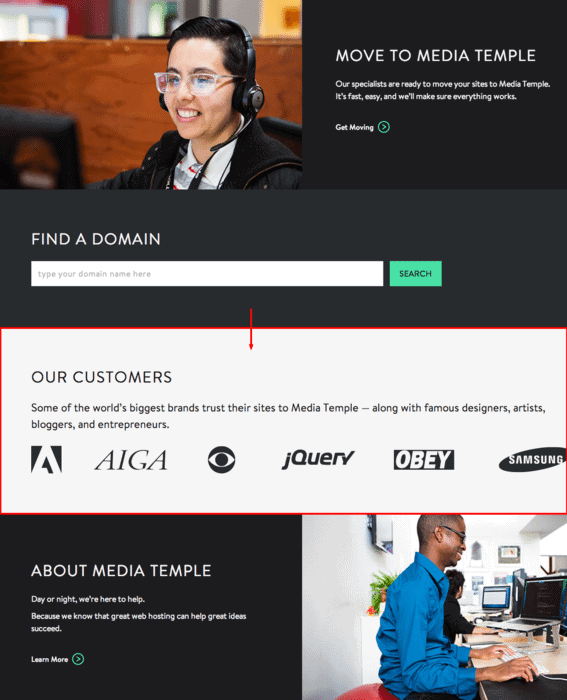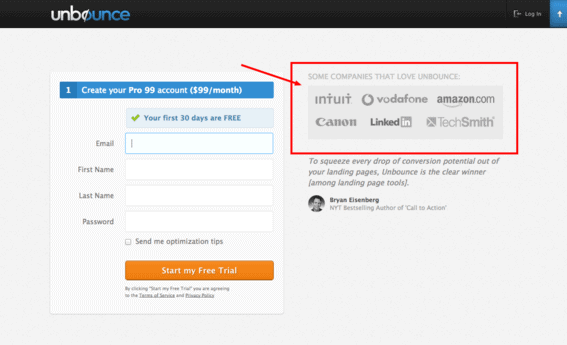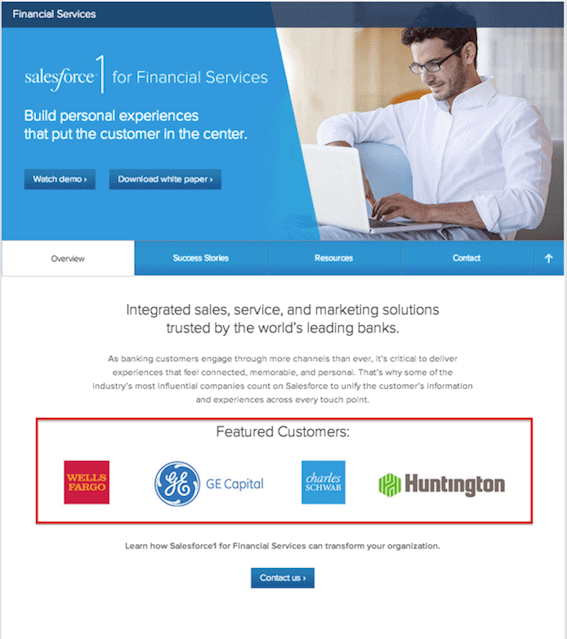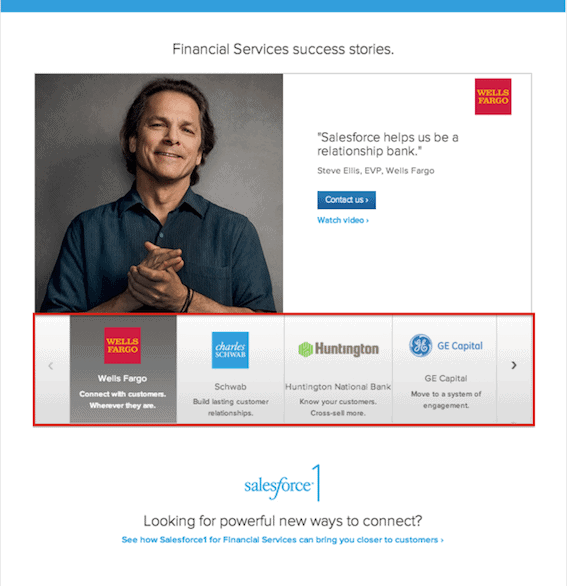When a user experiences any form of social proof in proximity to an offering, its impact is immediately greater—now it’s part of your website’s entire conversion strategy and conversion funnel. Positioned correctly, a client logo should dissuade consumer waffling and instead carefully coax your prospects to convert at just the right time.
For instance, Optimizely, an international digital measurement and analytics company, conducted an A/B test proving that well-displayed and prominent client logos increased the conversion rate of product pages by 69%. This figure was determined after 2,500 visitors viewed the site and these pages.
Below are 3 great examples of client logos working for a business:
- Media Temple: A top-tier web hosting service and support provider using client logos on their homepage
- Unbounce: A platform to build, publish and A/B test landing pages using client logos on their Free Trial sign-ups page
- Salesforce: A global cloud computing company using client logos TWICE on their financial services page
As shown, each company leverages their client logos at strategic points. For Media Temple, homepage logos offer familiarity to new users; for Unbounce, they gently encourage the user to fill out their form and click that orange CTA; and for Salesforce, they encourage the user to raise their hand and contact the company, or if they aren’t quite there yet, to crawl further into the site and learn more about the product.
Note: In addition to these instances alone, each of these companies embraces and enlists this social proof strategy site-wide—because they know that earning complete consumer trust can’t be left to just one spot on your website.
#3: Consider the Caveats—A Legal Look at How to Use Client Logos
Though touting your client’s logos IS a website design best practice, the strategy does not come void of any legal caveats. According to experts, before you incorporate company logos on your marketing materials, it is wise to ask and receive permission from the client first.
“It’s bad business manners to advertise that someone is your customer without prior permission. Some people just don’t like to be used as references without permission even if they would give the permissions gladly.” – John B. Farmer, a lawyer with the Leading-Edge Law Group, PLC, an entity specializing in intellectual property law
To be safe, this means you’ll want to obtain written permission from your clients. You may write to your clients requesting this permission, or you could craft explicit language into your contractual documents indicating that you may use your customer’s name and logo to publicly advertise your relationship.
In any case, you’re trying to protect your business from any copyright infringement laws, which prohibit “the unauthorized use of works under copyright… [Including] the right to reproduce, distribute or display,” writes Nasir N. Pasha, a business attorney at PashaLaw.com.
Pasha also goes on to explain that though a logo might be trademarked, using your client logos on your site in a manner consistent with the website design best practice we’ve recommended is not a trademark infringement and should not be mistaken for one. Trademark infringement is more concerned with the deliberate use of a mark in a manner that purposefully causes confusion, i.e., makes a site visitor believe your site is actually the site of the client you are boasting.
No Harm, No Foul
However, in the end, fear not if you plan to or have used a client logo sans permission. As most intellectual property attorneys, brand specialists, and marketing consultants indicate, even if you use logos without permission, the chances of any legal ramification are very slim—most organizations will just ask that you stop, which is easily done in the digital age.
At the end of the day, the best websites are not just attractive; they are truly compelling. They not only market products and services, they give proof that what they sell is desirable. So, as a business owner seeking such success, you must be willing to conform to today’s website design practices—including client logo validation strategies.
Remember, people trust people! It’s like monkey see, monkey do… take it away, King Louis:
“Oh, oobee, doo
I wan’na be like you
I wan’na to walk like you
Talk like you, too
You’ll see it’s true
Someone like me
Can learn to be
Like someone like you”
So, don’t leave it up to your website visitors to decide their path—show them the way!
At Vital, we’ve worked with countless companies to meet their marketing objectives, delivering dedicated digital marketing strategies that leverage the most complete website design best practices.
Let us know how you use your client logos to improve your site’s performance, or let us know how we can help you. Contact us today—our inbound marketing team can’t wait to hear from you!





![How to Make a Content Style Guide as Unique as Your Brand [w/ Free Template!] 12 content-style-guide](https://vitaldesign.com/wp-content/uploads/2018/05/content-style-guide-818x596.jpg)